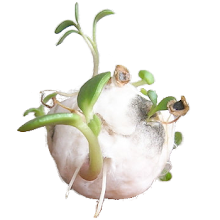
I never thought of my garden in this way, but when I read this quote, it made me smile. My garden truly is my autobiography. My fingerprints are in the soil, my design aesthetic is in the shape and color of the plants. But more than that, the origin of many of the plants are the main chapters of my autobiography.
When we first moved into our house many years ago, I knew the basics of gardening but I was intimidated by the scrubby little garden that I now owned. The front of the house, along a street, was lined with ugly, forgotten evergreen bushes that needed aggressive pruning at the very least. An unhappy Holly bush, brown and dull instead of glossy, slouched beneath a steady drip from the roof during every rainstorm. Some Lily of the Valley had taken over and choked out all other plants but still managed to look patchy and irritated. Behind the house lived two overgrown Privet, leggy and filled with suckers darting out in every direction. A weedy lawn had barely any grass because the firmly-packed clay soil wouldn't allow roots to breathe, and a run of chain link fence was supporting some kind of vine with huge, sharp thorns — no, thorns is too nice a word. Spikes of death.
I stared at this sad little garden and yard for a year or two before I got the courage to attack it. For some reason, I thought I had to re-plant the whole area into a beautiful, mature garden in one fell swoop, and this overwhelmed me into paralysis. (To be honest, I was also spending most of my energy and money on the inside of the house.)
Something drove me over the edge one spring. On a beautiful day that called to me to be digging, I tore out the Holly bush, transplanted an area of the Lily of the Valley, and visited my local nursery. By the end of the summer I had torn out all the other straggly evergreens and transplanted or given away the rest of the Lily of the Valley, and planted some lovely perennials. (I learned that the best way to transplant the Lily of the Valley is to pull it up, cluster three plants together, wrap the tap roots together and loosely tie them, then replant.)
At the same time, I was eyeing the extensive mature gardens that my parents had tended for several decades at my childhood home. Whenever they divided their Irises, which needed more space at least every other year, I took a basket full of bulbs and planted them along the base of my fence, changed out for a wooden one with pickets. When they bloomed, I expected a garden full of purple Irises and was surprised to see a yellow one here and there. My parents (who are only the fourth family to live in their 200+-year-old house) explained that those yellow flowers were planted by the last generation of the original family who built the house. I couldn't bear to pluck them out now that I knew their history, and that they not only came from my childhood home, but from the families who had come before my own.
Next came the bee balm, angrily pulled out by my parents when these red flowers became too aggressive and spread too quickly. I had the perfect place for such a greedy plant, in an area against a sidewalk where I wouldn't mind if they tried to take over. I surrounded a shallow-rooted maple tree with a ring of Vinca, copying how my mom had done so decades earlier to yield today's thick rings that have grown out and joined together with nearby rings, creating a beautiful carpet of shiny green leaves. A crabapple tree from a local nursery was purchased and wrangled into the ground to remind me of the one outside the kitchen window at my childhood home. Nothing makes me happier than to see it bursting in spring with deep burgundy blossoms. One of the loveliest smells of my youth was the fragrance from lilacs, wafting into my bedroom in the evening through my open window, commingled with the sound of whippoorwills. (The thought of this memory makes my shoulders relax even now.) A graft from that lilac bush easily took in my own yard and has already spread more than I wanted, perhaps thriving to know how much love I have for it.
I could tell you more: about the Hydrangea, about the Scilla - with the sweet cobalt blue flower - that come soon after the snow departs, and about the strange plant that my folks call "elephant ears" (because of their size and shape) that love shade and moisture and have happily stretched out all over the area where an unhappy Holly bush once hunched like a frown. But instead, I think you should buy the book!

No comments:
Post a Comment